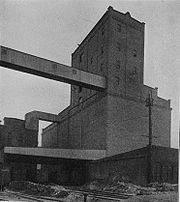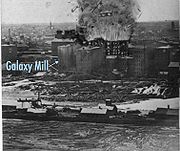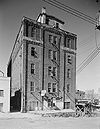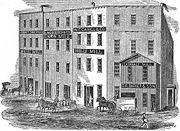
Northwestern Consolidated Milling Company
Encyclopedia


United States
The United States of America is a federal constitutional republic comprising fifty states and a federal district...
flour milling
Gristmill
The terms gristmill or grist mill can refer either to a building in which grain is ground into flour, or to the grinding mechanism itself.- Early history :...
company that operated about one quarter of the mills in Minneapolis, Minnesota
Minneapolis, Minnesota
Minneapolis , nicknamed "City of Lakes" and the "Mill City," is the county seat of Hennepin County, the largest city in the U.S. state of Minnesota, and the 48th largest in the United States...
when the city was the flour milling capital of the world. Formed as a business entity, Northwestern produced flour
Flour
Flour is a powder which is made by grinding cereal grains, other seeds or roots . It is the main ingredient of bread, which is a staple food for many cultures, making the availability of adequate supplies of flour a major economic and political issue at various times throughout history...
for the half century between 1891 and 1953, when its A Mill was converted to storage and light manufacturing. At its founding, Northwestern was the city's and the world's second largest flour milling company after Pillsbury, with what is today General Mills
General Mills
General Mills, Inc. is an American Fortune 500 corporation, primarily concerned with food products, which is headquartered in Golden Valley, Minnesota, a suburb of Minneapolis. The company markets many well-known brands, such as Betty Crocker, Yoplait, Colombo, Totinos, Jeno's, Pillsbury, Green...
a close third. The company was touched by an attempt at U.S. monopoly
Monopoly
A monopoly exists when a specific person or enterprise is the only supplier of a particular commodity...
and became part of a Minneapolis oligopoly
Oligopoly
An oligopoly is a market form in which a market or industry is dominated by a small number of sellers . The word is derived, by analogy with "monopoly", from the Greek ὀλίγοι "few" + πόλειν "to sell". Because there are few sellers, each oligopolist is likely to be aware of the actions of the others...
that valued in 1905 owned almost 9% of the country's flour and grist
Grist
Grist is grain that has been separated from its chaff in preparation for grinding. It can also mean grain that has been ground at a grist mill. Its etymology derives from the verb grind....
products.
History

Northwestern and their new Ceresota flour brand name were established in July 1891 by a group of businessmen led by former lumberman John Martin
John Martin (businessman)
John Martin of Peacham, Vermont was an American steamboat captain and businessman in Minneapolis, Minnesota involved in lumber and flour milling. In 1891, Martin led a merger of six mills to create Northwestern Consolidated Milling Company, at the time the world's second largest flour milling...
at six independent existing mills—the Crown Roller (2,500 barrels/day), Columbia (2,000), Northwestern (1,600), Pettit (1,600, to be an elevator), Galaxy (1,500) and Zenith (1,100). Martin became president, Joel B. Bassett was vice president, C. T. Fox was secretary and treasurer, and Fred C. Pillsbury, E. Zeidler and Albert C. Loring were the managers. The company grew to nine mills and several elevator and storage facilities. Loring's father Charles M. Loring
Charles M. Loring
Charles Morgridge Loring was an American businessperson, miller and publicist. Raised in Maine to be a sea captain, Loring instead became a civic leader in Minneapolis, Minnesota where he was a wealthy flour miller and in Riverside, California where he helped to build the first city hall...
was one of the directors.
Northwestern's first decade was marked by financial instability because its founders paid too much for its properties and suffered from lack of capital. A reorganization followed in 1895 that somewhat alleviated the company's problems. In 1889-1990 the United States Milling Company formed at the Hecker-Jones-Jewell mills in New York City
New York City
New York is the most populous city in the United States and the center of the New York Metropolitan Area, one of the most populous metropolitan areas in the world. New York exerts a significant impact upon global commerce, finance, media, art, fashion, research, technology, education, and...
with the goal of becoming a flour monopoly by owning nearly all of the country's spring wheat mills. Northwestern, though, was the only company they acquired. Financially troubled, U.S. Milling in 1900 reorganized and became the Standard Milling Company with Northwestern as a subsidiary.
By combining six mills, Northwestern's capacity was the second largest in the world at the time of its founding, after the giant Pillsbury-Washburn, and slightly more than Washburn, Crosby
General Mills
General Mills, Inc. is an American Fortune 500 corporation, primarily concerned with food products, which is headquartered in Golden Valley, Minnesota, a suburb of Minneapolis. The company markets many well-known brands, such as Betty Crocker, Yoplait, Colombo, Totinos, Jeno's, Pillsbury, Green...
. By 1900, these three companies were an oligopoly holding 97% of the Minneapolis market. In 1928 Washburn, Crosby became General Mills in a merger of U.S. millers and surpassed Pillsbury to become the world's largest flour milling company. In recent years General Mills acquired Pillsbury.
In January 1909, Northwestern opened its state of the art Elevator A
Ceresota Building
Northwestern Consolidated Milling Company Elevator A also known as the Ceresota Building and "The Million Bushel Elevator" was a receiving and public grain elevator built by the Northwestern Consolidated Milling Company in 1908 in Minneapolis, Minnesota in the United States...
, possibly the largest grain elevator
Grain elevator
A grain elevator is a tower containing a bucket elevator, which scoops up, elevates, and then uses gravity to deposit grain in a silo or other storage facility...
ever built of brick
Brick
A brick is a block of ceramic material used in masonry construction, usually laid using various kinds of mortar. It has been regarded as one of the longest lasting and strongest building materials used throughout history.-History:...
. The elevator could hold 1,000,000 bushel
Bushel
A bushel is an imperial and U.S. customary unit of dry volume, equivalent in each of these systems to 4 pecks or 8 gallons. It is used for volumes of dry commodities , most often in agriculture...
s of grain and its conveyors could each move 10,000 bushels per hour to the Crown Roller and Standard mills. Along with Elevator B known as the Pettit Mill of which only the foundation remains, Elevator A is a contributing property of the Saint Anthony Falls History District
Saint Anthony Falls
Saint Anthony Falls, or the Falls of Saint Anthony, located northeast of downtown Minneapolis, Minnesota, was the only natural major waterfall on the Upper Mississippi River. The natural falls was replaced by a concrete overflow spillway after it partially collapsed in 1869...
listed in the National Register of Historic Places
National Register of Historic Places
The National Register of Historic Places is the United States government's official list of districts, sites, buildings, structures, and objects deemed worthy of preservation...
in 1971.
Today

Ceresota Building
Northwestern Consolidated Milling Company Elevator A also known as the Ceresota Building and "The Million Bushel Elevator" was a receiving and public grain elevator built by the Northwestern Consolidated Milling Company in 1908 in Minneapolis, Minnesota in the United States...
, and the Crown Roller Mill are in use today as office buildings. The Standard Mill became the Whitney Hotel but is closed. Ceresota is now a brand name of The Uhlmann Company and American Home Foods.
Mills
| Northwestern Consol. Mills | ||||||
|---|---|---|---|---|---|---|
| Mill | Owners | Architect/Construction | Extant | Northwestern | Remains | Image |
| Crown Roller Mill | Charles Morgan Hardenbergh, John A. Christian, Llewellyn Christian, Charles Everett French | William F. Gunn | 1879- | A Mill | office building |  |
| Columbia Mill | Columbia Mill Company | 1882-1941 | B Mill aka Ceresota Mill | under Fuji-Ya, visible from Mississippi | ||
| Galaxy Mill | W.P. Ankeny, W. F. Cahill, Loren Fletcher Loren Fletcher Loren Fletcher was a U.S. Representative from Minnesota; born in Mount Vernon, Kennebec County, Maine; he attended the public schools and Maine Wesleyan Seminary, Kents Hill, Maine; moved to Bangor in 1853; was a stonecutter, clerk in a store, and an employee of a lumber company; moved to... , Charles M. Loring Charles M. Loring Charles Morgridge Loring was an American businessperson, miller and publicist. Raised in Maine to be a sea captain, Loring instead became a civic leader in Minneapolis, Minnesota where he was a wealthy flour miller and in Riverside, California where he helped to build the first city hall... , Albert C. Loring |
1874-1931 | C Mill | foundation visible, Mill Ruins Park Mill Ruins Park Mill Ruins Park is a park in downtown Minneapolis, Minnesota, United States, standing on the west side of Saint Anthony Falls on the Mississippi River. The park interprets the history of flour milling in Minneapolis and shows the ruins of several flour mills that were abandoned.The park is the... |
 |
|
| Northwestern Mill | Siddle, Loren Fletcher Loren Fletcher Loren Fletcher was a U.S. Representative from Minnesota; born in Mount Vernon, Kennebec County, Maine; he attended the public schools and Maine Wesleyan Seminary, Kents Hill, Maine; moved to Bangor in 1853; was a stonecutter, clerk in a store, and an employee of a lumber company; moved to... and Holmes, John Martin John Martin (businessman) John Martin of Peacham, Vermont was an American steamboat captain and businessman in Minneapolis, Minnesota involved in lumber and flour milling. In 1891, Martin led a merger of six mills to create Northwestern Consolidated Milling Company, at the time the world's second largest flour milling... |
1879-1931 | D Mill | foundation visible, Mill Ruins Park | image | |
| Zenith Mill | Leonard Day and M.B. Rollins | 1871-1931 | E Mill | foundation visible, Mill Ruins Park | image | |
| Standard Mill | Ebenezer White and Dorilus Morrison Dorilus Morrison Dorilus Morrison was a banker, businessman, and politician who lived in the U.S. state of Minnesota. He was the first and third mayor of Minneapolis. Morrison was born in Livermore, Maine, and was a lumber merchant in Bangor, Maine before moving to Minnesota. He was the cousin of William D... , Whitney Hotel |
Otis Arkwright Pray and William Dixon Gray | 1879- | F Mill | standing |  |
| Arctic/St. Anthony Mill | Perkins, Crocker, and Co., Hineline, Plenk and Wheeler | 1866-1919 | H Mill | foundation visible |  |
|
| Elevator A Ceresota Building Northwestern Consolidated Milling Company Elevator A also known as the Ceresota Building and "The Million Bushel Elevator" was a receiving and public grain elevator built by the Northwestern Consolidated Milling Company in 1908 in Minneapolis, Minnesota in the United States... |
Northwestern | George T. Honstain, Fred W. Cooley | 1908- | Elevator A | | office building |  |
| Pettit Mill | Pettit, Robinson, and Company | 1875-1931 | Elevator B | visible, Mill Ruins Park | image | |
| New City Waterworks | City of Minneapolis | 1883-ca.1931 | storage | foundation remains | ||
| Union Mill | Henry Gibson | 1863-ca. 1919/29 | storage | foundation visible |  |
|
| Minneapolis Boiler Works | M.W. Glenn, unknown | ca. 1878 - 1985 | storage | foundation probably destroyed |  |
|
| Phoenix Iron Works | D. Douglas and J.M. Schultz, Wilford and Northway | ca.1881-1985 | storage | foundation probably destroyed | ||

